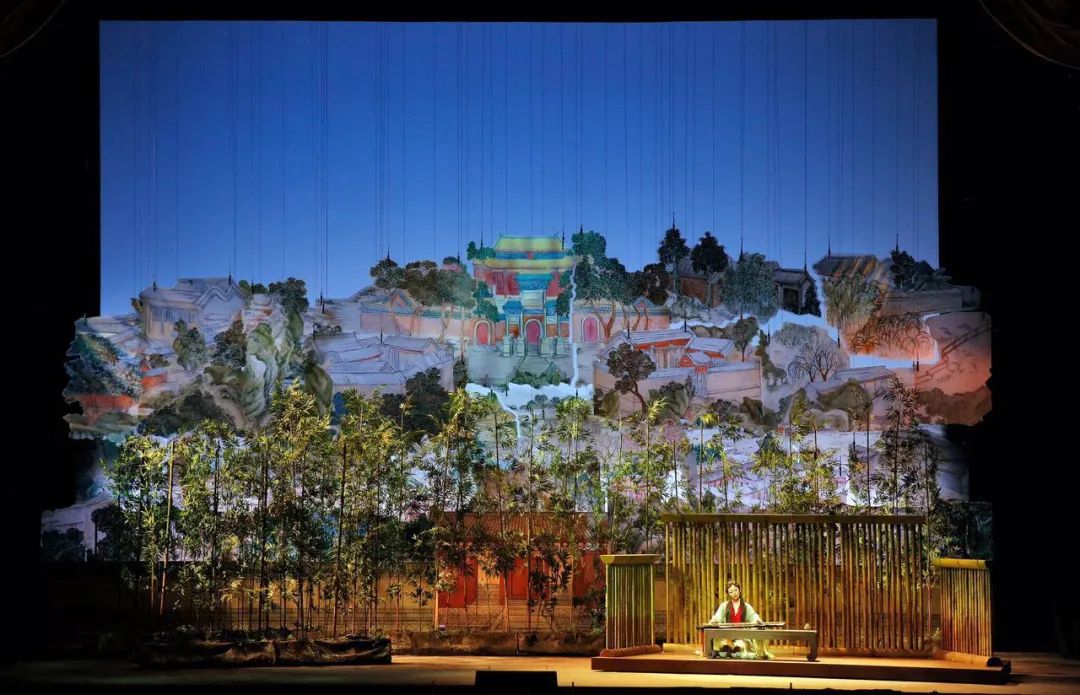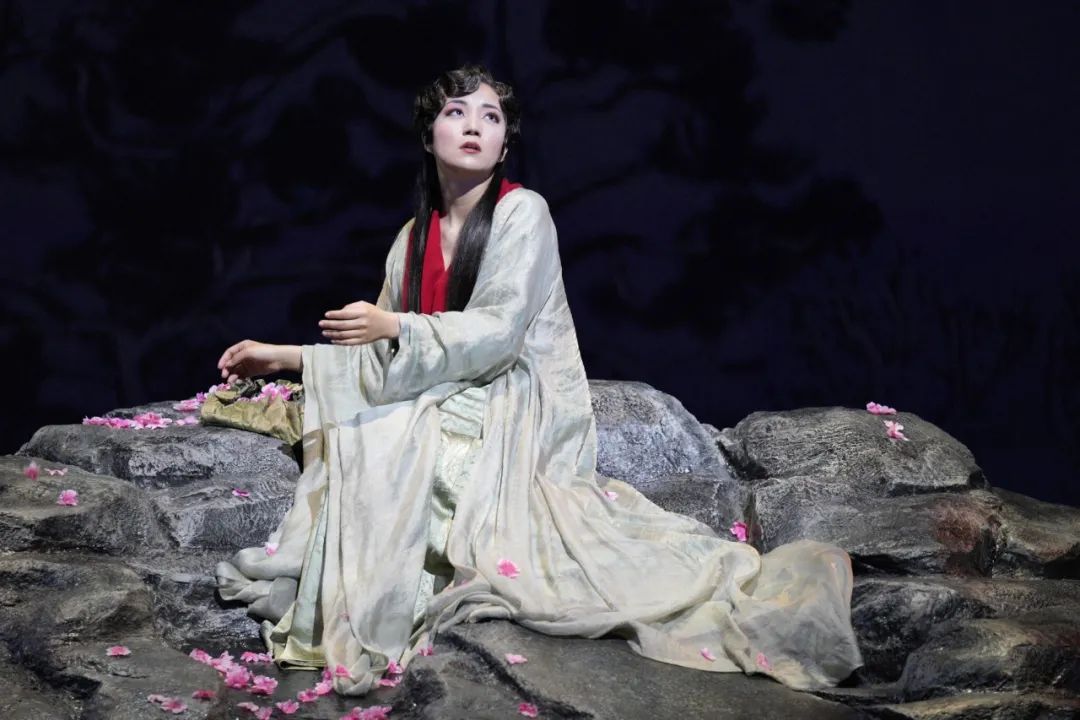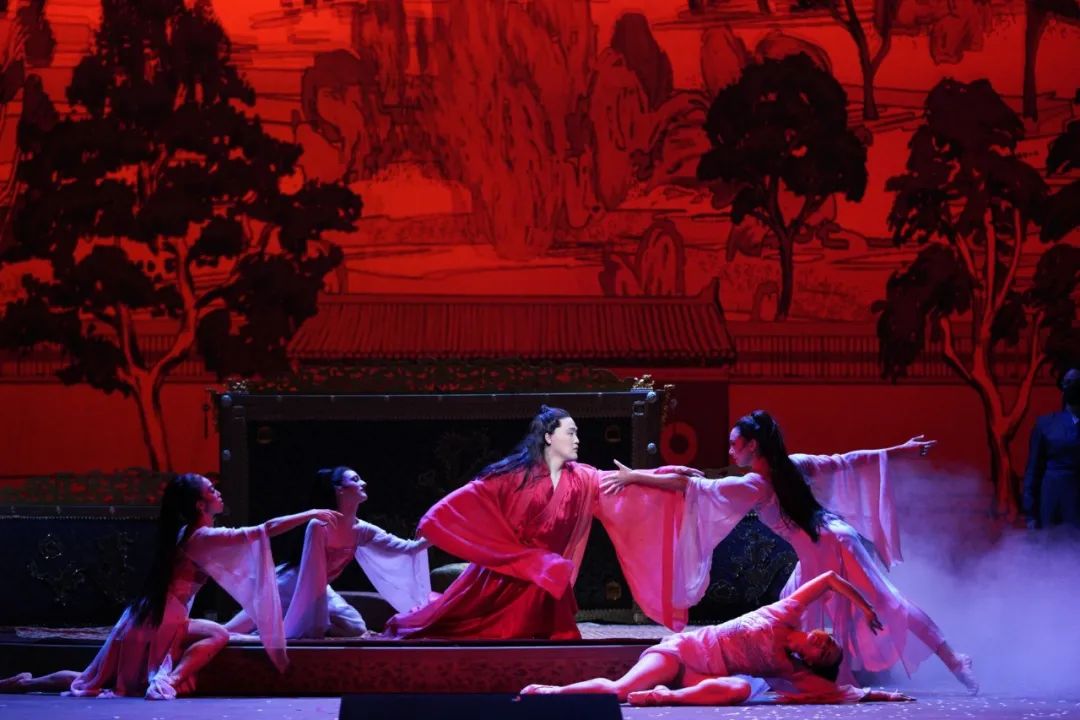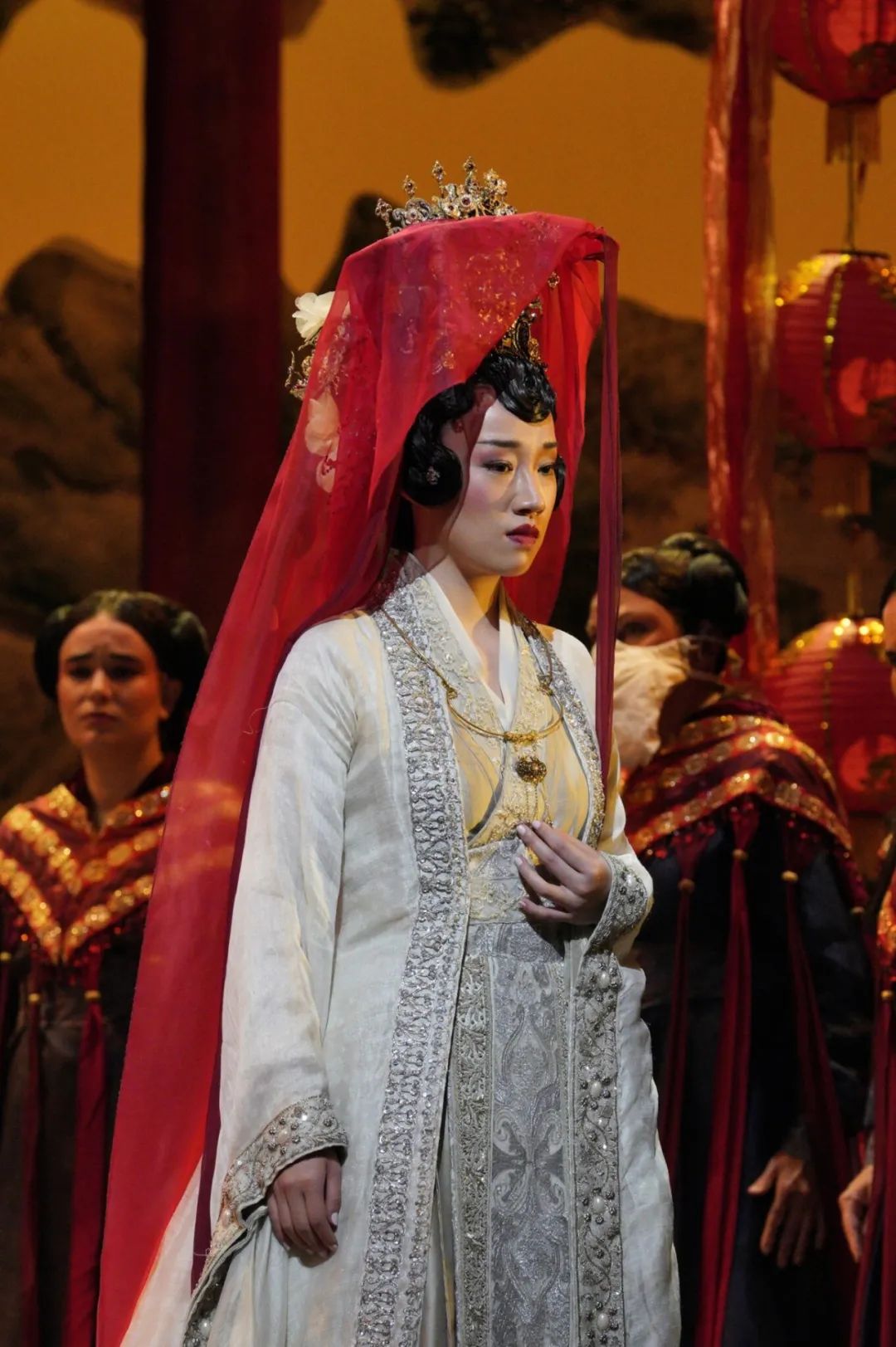After a lapse of six years, the opera "A Dream of Red Mansions" has returned to the San Francisco Opera.
On the evening of June 14, local time in San Francisco, the opera "Dream of Red Mansions", composed by Sheng Zongliang, co-written by Huang Zelun and Sheng Zongliang, directed by Lai Shengchuan, choreographed by Ye Jintian, and choreographed by Xu Fangyi, appeared at the San Francisco Opera House.
In September 2016, the English-language opera made its world premiere at the San Francisco Opera House, drawing widespread attention in the industry. Six years later, "Dream of Red Mansions" jointly created by the Chinese "Dream Team" revisited the old place, bringing an opera feast derived from Chinese literary classics to the audience on the other side of the ocean.
This round of performances runs from June 14th to July 3rd. At 14:00 on June 19th local time (5:00 on June 20th, Beijing time), the opera "A Dream of Red Mansions" will be broadcast live on the official website of the San Francisco Opera House ($25). You can check back within hours.


It was a huge challenge for the creative team to condense a 120-episode novel into a two and a half hour story.
Huang Zhelun, who is good at telling stories on the Western stage, and Sheng Zongliang, who loves "A Dream of Red Mansions", have sorted out "A Dream of Red Mansions" with many clues and intricate relationships between characters. Love is the main line, with the rise and fall of Jia's house as the background.
"The tragic and unfortunate love tragedy and family suffering are attractive to everyone." When composing music, Sheng Zongliang incorporated a lot of Chinese elements. For example, he added guqin to the poems of Baodai Bamboo Forest, and Shanghai opera in Baoyu's wedding. The melody of "Purple Bamboo" uses gongs and drums in traditional Peking Opera to set off the atmosphere, adding a touch of Chinese-style tenderness to the opera.
Ye Jintian also used a lot of Chinese elements on the stage, such as brocade, looms, kites, and also used six translucent paintings to form a huge mobile installation, showing the whole picture of "Grand View Garden", creating a stage combining virtual and real . In costume design, he compared Baoyu and Daiyu to stones and water, and there are many designs related to stones and water on the stage.
Not only is the production team known as the Chinese "Dream Team", but on the night of the world premiere, the main actors in the play are all from Asia - Chinese tenor Shi Yijie plays Baoyu, Korean soprano Cao Qing plays Daiyu, Japanese mezzo-soprano Elling Roberts plays Baochai.
This is the first time that "A Dream of Red Mansions" has been adapted into an English opera, and it is also the first work in the history of the San Francisco Opera to use Chinese and English subtitles in the performance. Jay Xu, director of the San Francisco Asian Art Museum, believes that the performance of "A Dream of Red Mansions" at the San Francisco Opera House provides a window for the export of Chinese classical literature and Chinese culture, just as Shakespeare's plays played a role in the promotion of British literature and culture. works the same.
In March 2017, the opera "Dream of Red Mansions" landed at the Hong Kong Arts Festival, meeting Asian audiences for the first time. Conductor Tang Muhai conducts the Hong Kong Philharmonic Orchestra and joins forces with seven Asian singers to recreate the most beautiful world of Chinese literature on the Hong Kong stage. In September of the same year, the opera "Dream of Red Mansions" debuted in mainland China and toured in Beijing, Changsha and Wuhan. Composer Sheng Zongliang was the conductor, conducting his own opera for the first time.



In this revisit to the San Francisco Opera House, the opera "Dream of Red Mansions" still retains the lineup of Asian actors leading the role. Korean tenor Jin Jianyu plays Baoyu, Chinese soprano Zhang Meimei plays Daiyu, and Chinese mezzo-soprano Wu Hongni plays Baochai.
Starring Asian actors is what the screenwriter Huang Zhe Lun insists on. Director Lai Shengchuan also believes that these Asian actors will be an eye-opener for everyone, "It's like a secret... The whole world doesn't know there are so many talented Asian opera singers."
The conductor Hong Yiquan from Singapore was invited to conduct the San Francisco Opera Orchestra and Choir. When leading the Shanghai Symphony Orchestra to hold a concert in February this year, Hong Yiquan once expressed to the Shanghai reporter his yearning for conducting the opera "A Dream of Red Mansions". As a child, he entered the world of "Dream of Red Mansions" through comic strips. Growing up in Singapore, he used to communicate with his mother in Teochew dialect. Now he is the artistic director of the Sichuan Symphony Orchestra, and he is no stranger to Chinese culture.
"The true meaning of opera lies in condensing the complex situations and moods of a complex character into one note." Lai Shengchuan, a long-time director of stage plays, once sighed after switching to opera. When the orchestra, dancers, chorus, and singers gather together, it feels like Very special, incomparable with other arts.
In order to prepare for this round of performances, Lai Shengchuan arrived in San Francisco early. At the same time, he started the "Director's Life Notes" rehearsing "A Dream of Red Mansions" on Weibo.
This time, the crew had more time for rehearsal and more time for technical synthesis. Although the music did not decrease by one point, the play length was reduced by about ten minutes. "Where is the shortage? The connection between scenes and the performance in the play The details can save a lot of time and make the whole smoother.”
Lai Shengchuan also needs to be familiar with the time rhythm in the United States, but many complicated regulations make it difficult for him to adapt as a director.
The performing arts industry in the United States is constrained by trade unions as a whole, and the rehearsal time cannot be determined by the director’s ideas, but must be decided by the trade union. In principle, 80 minutes of rehearsal must have a 10-minute break; if there are dancers, there must be a 55-minute break of 5 minutes; if there is an orchestra, it is another rule... In addition, when the actors are taking a break, the director cannot talk to the actors, unless The actor took the initiative to find the director.
On the evening of June 14, local time in San Francisco, the opera "Dream of Red Mansions", composed by Sheng Zongliang, co-written by Huang Zelun and Sheng Zongliang, directed by Lai Shengchuan, choreographed by Ye Jintian, and choreographed by Xu Fangyi, appeared at the San Francisco Opera House.
In September 2016, the English-language opera made its world premiere at the San Francisco Opera House, drawing widespread attention in the industry. Six years later, "Dream of Red Mansions" jointly created by the Chinese "Dream Team" revisited the old place, bringing an opera feast derived from Chinese literary classics to the audience on the other side of the ocean.
This round of performances runs from June 14th to July 3rd. At 14:00 on June 19th local time (5:00 on June 20th, Beijing time), the opera "A Dream of Red Mansions" will be broadcast live on the official website of the San Francisco Opera House ($25). You can check back within hours.

Opera "Dream of Red Mansions" returns to San Francisco Opera

The performance of the opera "A Dream of Red Mansions". The pictures in this article are from the San Francisco Opera House, Photography: Cory Weaver
Join hands to create a dream, the Chinese dream team builds a production teamIt was a huge challenge for the creative team to condense a 120-episode novel into a two and a half hour story.
Huang Zhelun, who is good at telling stories on the Western stage, and Sheng Zongliang, who loves "A Dream of Red Mansions", have sorted out "A Dream of Red Mansions" with many clues and intricate relationships between characters. Love is the main line, with the rise and fall of Jia's house as the background.
"The tragic and unfortunate love tragedy and family suffering are attractive to everyone." When composing music, Sheng Zongliang incorporated a lot of Chinese elements. For example, he added guqin to the poems of Baodai Bamboo Forest, and Shanghai opera in Baoyu's wedding. The melody of "Purple Bamboo" uses gongs and drums in traditional Peking Opera to set off the atmosphere, adding a touch of Chinese-style tenderness to the opera.
Ye Jintian also used a lot of Chinese elements on the stage, such as brocade, looms, kites, and also used six translucent paintings to form a huge mobile installation, showing the whole picture of "Grand View Garden", creating a stage combining virtual and real . In costume design, he compared Baoyu and Daiyu to stones and water, and there are many designs related to stones and water on the stage.
Not only is the production team known as the Chinese "Dream Team", but on the night of the world premiere, the main actors in the play are all from Asia - Chinese tenor Shi Yijie plays Baoyu, Korean soprano Cao Qing plays Daiyu, Japanese mezzo-soprano Elling Roberts plays Baochai.
This is the first time that "A Dream of Red Mansions" has been adapted into an English opera, and it is also the first work in the history of the San Francisco Opera to use Chinese and English subtitles in the performance. Jay Xu, director of the San Francisco Asian Art Museum, believes that the performance of "A Dream of Red Mansions" at the San Francisco Opera House provides a window for the export of Chinese classical literature and Chinese culture, just as Shakespeare's plays played a role in the promotion of British literature and culture. works the same.
In March 2017, the opera "Dream of Red Mansions" landed at the Hong Kong Arts Festival, meeting Asian audiences for the first time. Conductor Tang Muhai conducts the Hong Kong Philharmonic Orchestra and joins forces with seven Asian singers to recreate the most beautiful world of Chinese literature on the Hong Kong stage. In September of the same year, the opera "Dream of Red Mansions" debuted in mainland China and toured in Beijing, Changsha and Wuhan. Composer Sheng Zongliang was the conductor, conducting his own opera for the first time.

Zhang Rose as Daiyu

Jin Jianyu as Baoyu

Wu Hongni as Baochai
Revisiting old places, Asian opera singers still play the leading roleIn this revisit to the San Francisco Opera House, the opera "Dream of Red Mansions" still retains the lineup of Asian actors leading the role. Korean tenor Jin Jianyu plays Baoyu, Chinese soprano Zhang Meimei plays Daiyu, and Chinese mezzo-soprano Wu Hongni plays Baochai.
Starring Asian actors is what the screenwriter Huang Zhe Lun insists on. Director Lai Shengchuan also believes that these Asian actors will be an eye-opener for everyone, "It's like a secret... The whole world doesn't know there are so many talented Asian opera singers."
The conductor Hong Yiquan from Singapore was invited to conduct the San Francisco Opera Orchestra and Choir. When leading the Shanghai Symphony Orchestra to hold a concert in February this year, Hong Yiquan once expressed to the Shanghai reporter his yearning for conducting the opera "A Dream of Red Mansions". As a child, he entered the world of "Dream of Red Mansions" through comic strips. Growing up in Singapore, he used to communicate with his mother in Teochew dialect. Now he is the artistic director of the Sichuan Symphony Orchestra, and he is no stranger to Chinese culture.
"The true meaning of opera lies in condensing the complex situations and moods of a complex character into one note." Lai Shengchuan, a long-time director of stage plays, once sighed after switching to opera. When the orchestra, dancers, chorus, and singers gather together, it feels like Very special, incomparable with other arts.
In order to prepare for this round of performances, Lai Shengchuan arrived in San Francisco early. At the same time, he started the "Director's Life Notes" rehearsing "A Dream of Red Mansions" on Weibo.
This time, the crew had more time for rehearsal and more time for technical synthesis. Although the music did not decrease by one point, the play length was reduced by about ten minutes. "Where is the shortage? The connection between scenes and the performance in the play The details can save a lot of time and make the whole smoother.”
Lai Shengchuan also needs to be familiar with the time rhythm in the United States, but many complicated regulations make it difficult for him to adapt as a director.
The performing arts industry in the United States is constrained by trade unions as a whole, and the rehearsal time cannot be determined by the director’s ideas, but must be decided by the trade union. In principle, 80 minutes of rehearsal must have a 10-minute break; if there are dancers, there must be a 55-minute break of 5 minutes; if there is an orchestra, it is another rule... In addition, when the actors are taking a break, the director cannot talk to the actors, unless The actor took the initiative to find the director.










Comments